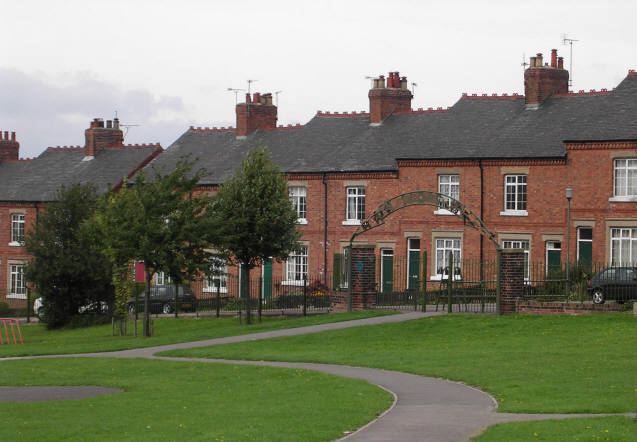New Bolsover is a model villageType of mostly self-contained community, built from the late 18th century onwards by landowners and industrialists to house their workers. adjoining the town of Bolsover in Derbyshire. It was built by the local colliery company to house its workers. The architects Brewill and Baily built the houses around a village green.
The houses are Grade II listed buildingsStructure of particular architectural and/or historic interest deserving of special protection..
History
The model pit village was started in 1891 by the Bolsover Colliery Company.
[1] It is a model village built by philanthropic colliery owners to benefit and improve the lives of workers at Bolsover Colliery. The architects for the village were Arthur Brewill and Basil Baily of Nottingham.[1][2]
The Model as it is known locally was completed in 1896; with two hundred houses for miners and colliery officials. A tram track round the back of the village linked it to the pit, delivering coal directly from the colliery to the coal store behind each house and carrying away the contents of the ash priviesSmall outhouse containing a seat underneath which was a bucket into which the user would defecate. The buckets were regularly removed and emptied by the local authority..[1] The “Model” remains in good repair, and its houses are either privately owned or owned by the local authority.
The village had a school and a Cooperative store. On the edge of the village were allotments, pig sties and the village cricket pitch. The village had no public houses, but the village institute served workers with no more than three glasses of beer a day. The colliery company employed a policeman, and anti-social behavior could result in fines or dismissal.[1]
Architecture
The village houses are built in a double horseshoe around a village green.[1] Two-storey cottages with attics were built in terraces of eight in red brick with a decorative first floor band and saw tooth eaves cornices. Their Welsh slate roofs have decorative ridge cresting. Each house has three-light casement windows in ashlarMasonry of squared and finely cut or worked stone, commonly used for the facing of a building. surrounds and a doorway with ashlar lintels and an overlight. The first floors have two-light casement windows under chamfered ashlar lintels. Gabled dormers to the attics have two-light casements with small panel glazing.[3] Similar two-storey cottages were built without dormers to their attics. All the houses have back yards enclosed by brick walls. The village houses are Grade II listed buildings.[4]



